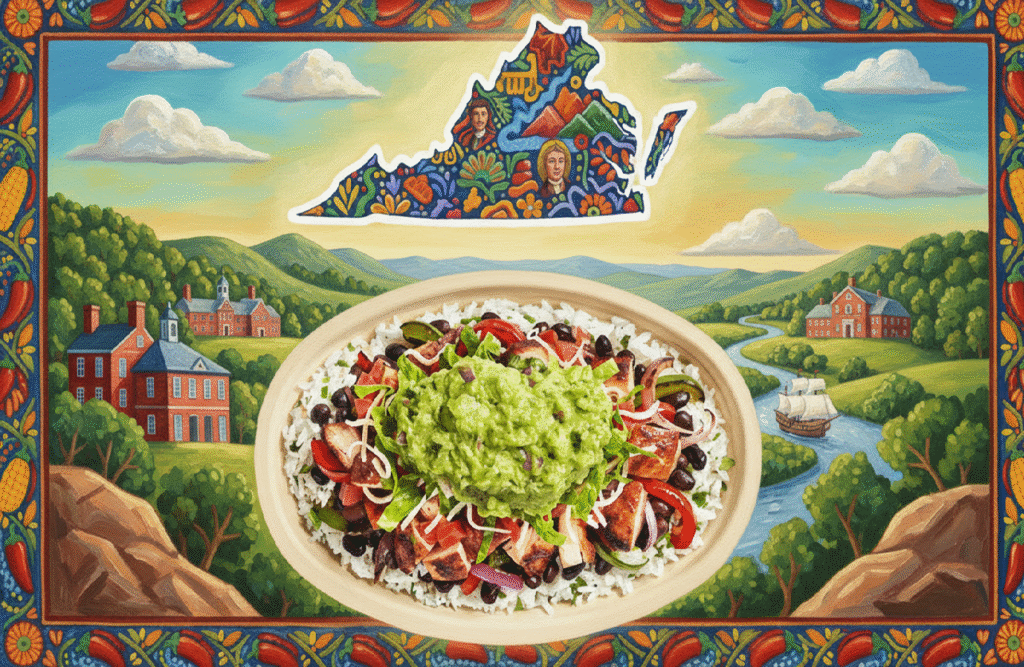Economists spend considerable time and energy dissecting broad macroeconomic trends—tracking whether prices are rising nationally by three percent or five percent, or whether taxes are too high, or whether interest rates are nudging them up or down. But in the process, they often overlook something just as important for households: the variation in cost of living across regions. It’s not just that prices are going up everywhere; it’s that they are higher in some places to begin with.
Nowhere is this clearer than in Virginia. Last month, during a visit to Harrisonburg for VEDA’s Fall Conference, I had a chicken burrito bowl for dinner. I was thrilled to pay only $8.60 for this meal. After all, at the Chipotle near my home in Fairfax County, a two-hour drive away, the identical chicken burrito bowl will set you back $10.35. That is almost exactly a 20 percent price difference for the exact same meal.
Are these price differences a big deal?
Based on this natural experiment, I set out to map the cost of a Chipotle chicken burrito bowl—the most standard of menu items—across all 140 Chipotle restaurants in the Commonwealth. No extra toppings, no delivery charges, no tips, no taxes, just the base price. What I found was telling. After checking the prices for chicken burrito bowls in each of Chipotle’s 140 locations, I was able to conclude that the average price of a Chipotle chicken burrito bowl in the commonwealth is $9.63. Some locations are cheaper, while others are more expensive.
When I plotted the full set of Virginia Chipotle locations, a clear pattern emerged: it is nearly impossible to get a chicken burrito bowl under ten dollars in Northern Virginia, while the same meal costs around 9 dollars in Virginia’s other major cities and suburbs, and below 9 dollars in more rural locations or college towns (Harrisonburg and Blacksburg, in particular).
Some people–especially those who get to pay a lower price–might argue that the difference between $8.60, $9.63, and $10.35 for the same meal is not really a big deal. After all, peoples’ perceptions are highly influenced by where they sit. But let me ask you this: would you like a 20 percent tax on restaurant meals? Because that is in essence what Northern Virginia is facing: a 10-20 percent surcharge on the same meal purchased for less elsewhere in the commonwealth. Put like this, a price differences that may initially seem minor suddenly becomes a bigger deal.
More than just lunch
In fact, the Chipotle chicken burrito bowl price index is not just a curiosity about fast (or convenient) food. The burrito bowl turns out to be a pretty good proxy for regional food costs overall. A Virginia Food Price Index based on food prices reported by the Economic Policy Institute’s Family Budget Calculator confirms what the Chipotle menu suggests: groceries and meals cost significantly more in Northern Virginia than in other parts of the state.
It may sound trivial to focus on one restaurant chain’s pricing, but the lesson runs deeper. Prices reflect the broader economic realities of a region: higher rents, higher food prices, and higher demand all feed into the cost of the same goods. If you live in Fairfax, Arlington, or Loudoun, the higher price of a burrito bowl is just one small daily reminder of the premium you pay on everyday life.
That premium adds up. A family in Northern Virginia doesn’t just face higher food costs; they are also paying more for housing, utilities, and services. Even when incomes are higher in Northern Virginia, those wages don’t stretch as far. As noted above, the higher cost of living is like living with a permanent tax in the form of elevated daily expenses. And that tax—in form of higher cost of living and a higher cost of doing business—is starting to be an economic drag on Northern Virginia, and in turn, on the Commonwealth as a whole.
A blind spot in economic debate
The problem is that policymakers often gloss over these regional differences. We debate whether inflation is “too high” or “under control,” but inflation is only part of the story. For many Virginians, the issue isn’t the year-over-year increase—it’s the higher baseline of prices that Northern Virginians have to pay every day because of their location. These higher prices are particularly burdensome for specific groups of residents in Northern Virginia, including essential workers in trades and services, recent college graduates and young professionals (such as teachers), federal employees affected by recent job eliminations, and seniors on fixed income.
From 2020 to 2024, the all-food Consumer Price Index (CPI) rose 23.6 percent over a five year period. That’s certainly a lot. In addition, however, food prices rise an addition 20 percent in the two-hour drive from Harrisonburg to Fairfax. You can think of this as 10 percent inflation per hour. It is a reminder that geography is destiny when it comes to what your paycheck actually buys.
Furthermore, the higher baseline will likely continue to interact with price increases over time: if inflation is running at three percent statewide, that’s applied on top of already higher prices in Northern Virginia. A three percent increase on $10.35 is not the same as a three percent increase on $8.60. In other words, continued inflation (for instance, due to international trade tariffs) hits certain parts of the state harder than other parts of the state.
A question for the Commonwealth
The final question, then, is whether Virginians outside Northern Virginia would tolerate these higher prices. Would residents of Harrisonburg, Roanoke, or Norfolk be happy paying more than $10 for a Chipotle chicken burrito bowl? My guess is no. Yet that’s exactly the reality their fellow Virginians face in the north every day.
As long as we only talk about statewide averages, we miss the lived experience of families in high-cost regions. Yet, the majority of state-level decision-makers and administrators live in the Richmond area–for instance, in Henrico County or in Chesterfield County–or elsewhere in the commonwealth where food prices are 10-20 percent lower than in Northern Virginia. And when state funding formulas or policy decisions made in Richmond fail to account for cost-of-living differences, they risk compounding inequality and slowing economic growth rather than addressing it.
So perhaps the humble burrito bowl deserves a place in our economic conversation. It may not solve Virginia’s cost-of-living divide, but it can at least make the problem visible—one delicious meal at a time.



